Blood Pressure and Its Regulation
Blood pressure refers to the force of blood exerted on the walls of the arteries as the heart pumps blood throughout the circulatory system. It is a crucial physiological parameter that, when regulated properly, ensures the delivery of oxygen and nutrients to body tissues. In this detailed note, we will explore blood pressure and the … Read more





